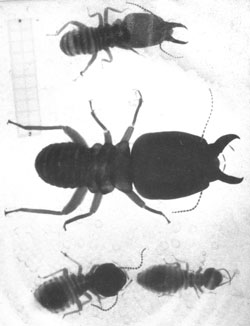Eugene Marais, The Soul of the White Ant (original title: Die Siel van die Mier, translated from Afrikaans by Winifred De Kok), London, 1937.
Die Siel van die Mier / The Soul of the White Ant
I first read this bundle of loving observations of the termite in its original Afrikaans, an edition printed in 1936 shortly after Marais’ death. The first page compelled me to read and read it all in one sitting, I became oblivious to the insipid prefab-surroundings of the Melbourne University library, and became entirely engrossed in Marias’ luminous world of white ants.
Eugène N. Marais (1871-1936) was a South African writer known mostly for his short prose and verse, yet he was also a keen naturalist who wrote in his native Afrikaans about the behaviour of animals. Marais developed an interminable interest in termites. His years of unceasing work in the field observing the cement like mounds of termitaria led Marais to formulate his theory that the individual nest of the termites is “similar in every respect to the organism of an animal, workers and soldiers resembling red and white blood cells, the fungus gardens the digestive organs, the queen functioning as the brain, and the sexual flight being in every aspect analogous to the escape of spermatozoa and ova.”
About six years after Marais’ articles appeared, nobel laureate Maurice Maeterlinck published his book, The Life of the White Ant, in which he describes this organic unity of the termitary and compares it with the human body. This theory aroused great interest at the time and was generally accepted as an original one formulated by Maeterlinck. The fact that an unknown South African observer had developed the theory so many years of arduous labour was not generally known in Europe.
You must consider a termitary as a single animal, whose organs have not yet been fused together as in a human being. Some of the termites form the mouth and digestive system; others take the place of weapons of defence like claws or horns; others form the generative organs. These flying termites are the generative organs of the colony. Every one of these winged insects is a potential king or queen. The four beautiful wings have taken months to develop and grow to perfection; months elapse — or even years in very dry districts — before an opportunity for flight occurs.
The full English translation online Soul of the White Ant
